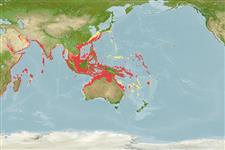Environment: milieu / climate zone / depth range / distribution range
экология
морской ассоциированный с рифами; пределы глубины 6 - 200 m (Ref. 2334). Tropical; 35°N - 33°S, 29°E - 180°E (Ref. 5222)
Indo-Pacific: Red Sea and the Persian Gulf to Natal, South Africa and east to Fiji, north to Japan, south to the Arafura Sea (Ref. 9819) and northern Australia. Recently recorded from Tonga (Ref. 53797). Appears to be absent from Micronesia, Polynesia, and most islands of the western Indian Ocean. Often confused with Epinephelus chlorostigma.
Length at first maturity / Size / Вес / Возраст
Maturity: Lm 20.0, range 19 - ? cm
Max length : 47.0 cm TL самец/пол неопределен; (Ref. 27266); common length : 35.0 cm TL самец/пол неопределен; (Ref. 5450); наибольший вес (опубликованные данные): 1.4 kg (Ref. 27266); наибольший возраст (опубликованны данные): 15 годы (Ref. 27352)
колючие лучи спинного плавника (общее число) : 11; членистые (мягкие) лучи спинного плавника (общее число) : 15 - 17; колючие лучи анального плавника: 3; членистые (мягкие) лучи анального плавника: 8. This species is distinguished by the following characters: body depth less than head length, 2.7-3.3 in SL (for specimens 14-31 cm SL); head length 2.4-2.8 in SL; D XI,15-17; pectoral rays 17-19 (usually 17-18); body scales ctenoid, cycloid scales on thorax and ventrally on abdomen; body with auxiliary scales; anal fin of adults rounded to slightly angular, longest soft ray 2.0-2.6 in HL; gill rakers of first gill arch 8-10 + 14-16; pyloric caeca 11-17; preopercle with 2-7 enlarged serrae at the angle; upper edge of operculum straight or slightly convex; midlateral part of lower jaw with 2 rows of teeth; lateral-line scales 49-53; caudal fin slightly convex in juveniles, truncate or slightly emarginate in adults. Colour of head, body, and fins pale, covered with numerous close-set brown, brownish yellow or greenish yellow spots (becoming smaller and increase in number as growth increases), the largest about size of pupil, those on front of head smaller than those on operculum; pectoral fins pale, with small dark spots on the rays; posterior edge of caudal fin with a distinct white margin (Ref. 39231, 90102).
Usually found in seagrass beds or on fine sediment bottoms near rocky reefs, dead coral, or alcyonarians (Ref. 5222), in shallow continental shelf waters (Ref. 27353). Juveniles are common at water depths to 80 m (Ref. 6390). Probably spawn during restricted periods and form aggregations when doing so (Ref. 27352). Eggs and early larvae are probably pelagic (Ref. 6390). Feed on fish and benthic invertebrates, primarily prawns and crabs (Ref. 4787, 27354). Caught with hook-and-line, traps, and trawls; common in the markets of Hong Kong, Singapore and probably throughout its range (Ref. 39231).
Heemstra, P.C. and J.E. Randall, 1993. FAO Species Catalogue. Vol. 16. Groupers of the world (family Serranidae, subfamily Epinephelinae). An annotated and illustrated catalogue of the grouper, rockcod, hind, coral grouper and lyretail species known to date. Rome: FAO. FAO Fish. Synop. 125(16):382 p. (Ref. 5222)
Статус Красного Списка МСОП (Ref. 130435)
Угроза для людей
Harmless
Использование человеком
рыболовство: коммерческий; аквакультура (рыбоводство): коммерческий
дополнительная информация
инструменты
Специальные отчеты
Скачать в формате XML
ресурсы в Интернет
Estimates based on models
Preferred temperature (Ref.
123201): 22.4 - 28.4, mean 26.9 °C (based on 1165 cells).
Phylogenetic diversity index (Ref.
82804): PD
50 = 0.5000 [Uniqueness, from 0.5 = low to 2.0 = high].
Bayesian length-weight: a=0.01175 (0.00828 - 0.01667), b=3.05 (2.95 - 3.15), in cm total length, based on LWR estimates for this species (Ref.
93245).
Trophic level (Ref.
69278): 3.7 ±0.3 se; based on diet studies.
устойчивость к внешним воздействиям (Ref.
120179): низкий, минимальное время удвоения популяции 4.5-14 лет (K=0.31; tm=2; tmax=25; Fec = 22,128).
Prior r = 0.28, 95% CL = 0.19 - 0.42, Based on 2 data-limited stock assessments.
Fishing Vulnerability (Ref.
59153): High vulnerability (59 of 100).
Climate Vulnerability (Ref.
125649): Moderate to high vulnerability (54 of 100).
Nutrients (Ref.
124155): Calcium = 25.8 [12.1, 55.4] mg/100g; Iron = 0.471 [0.250, 0.945] mg/100g; Protein = 18.2 [16.7, 19.7] %; Omega3 = 0.134 [0.085, 0.211] g/100g; Selenium = 43 [25, 75] μg/100g; VitaminA = 209 [60, 730] μg/100g; Zinc = 1.38 [0.96, 1.91] mg/100g (wet weight);
